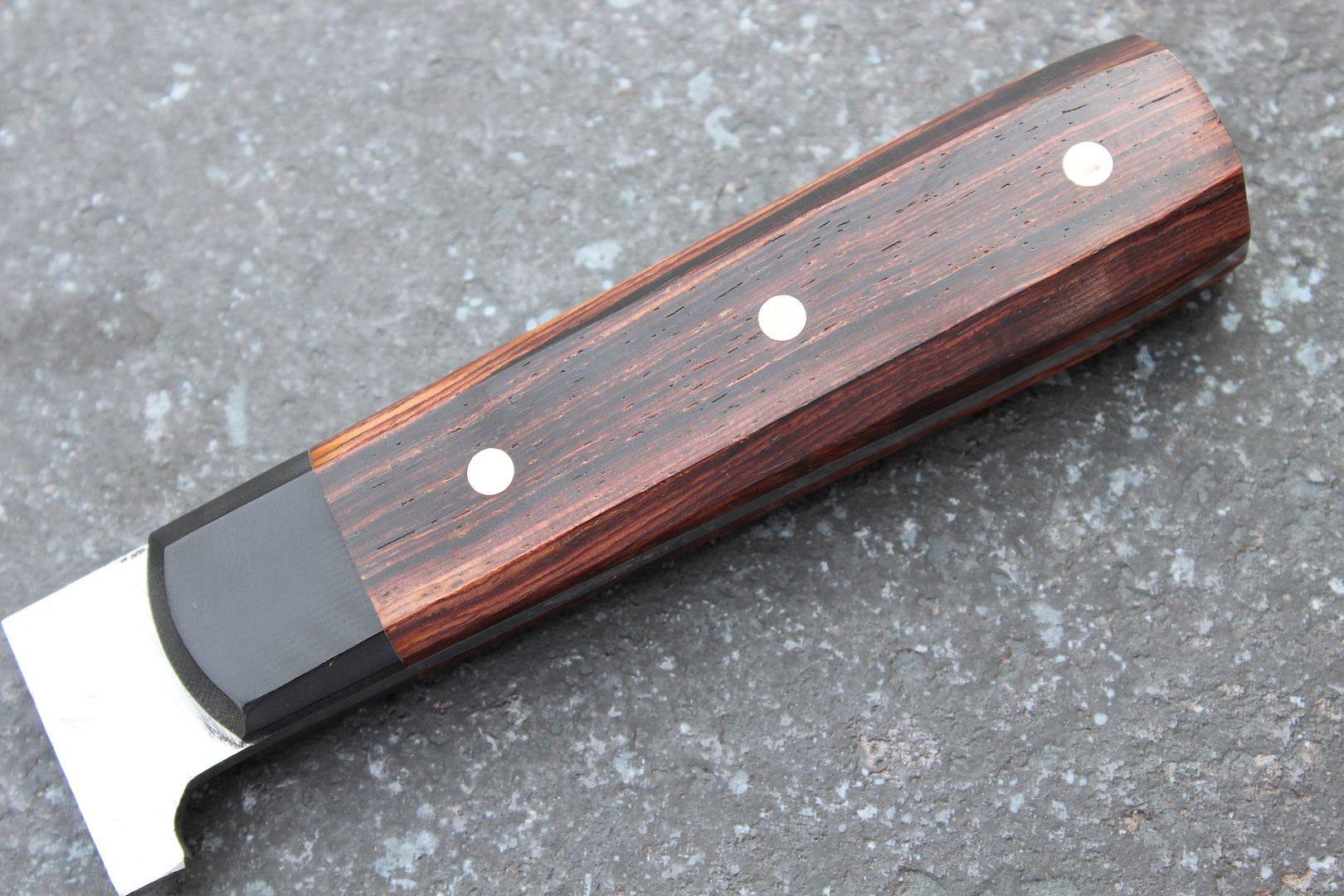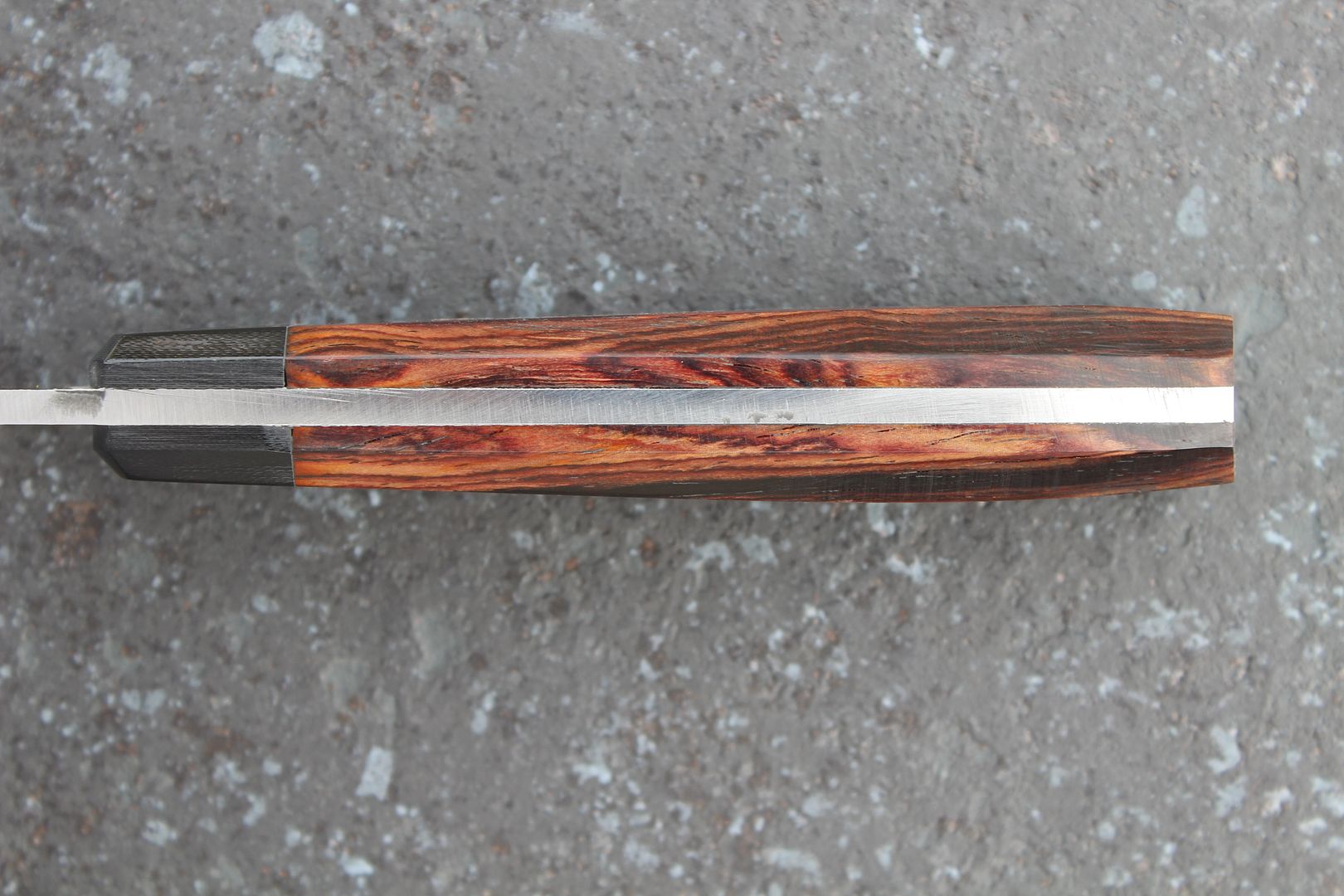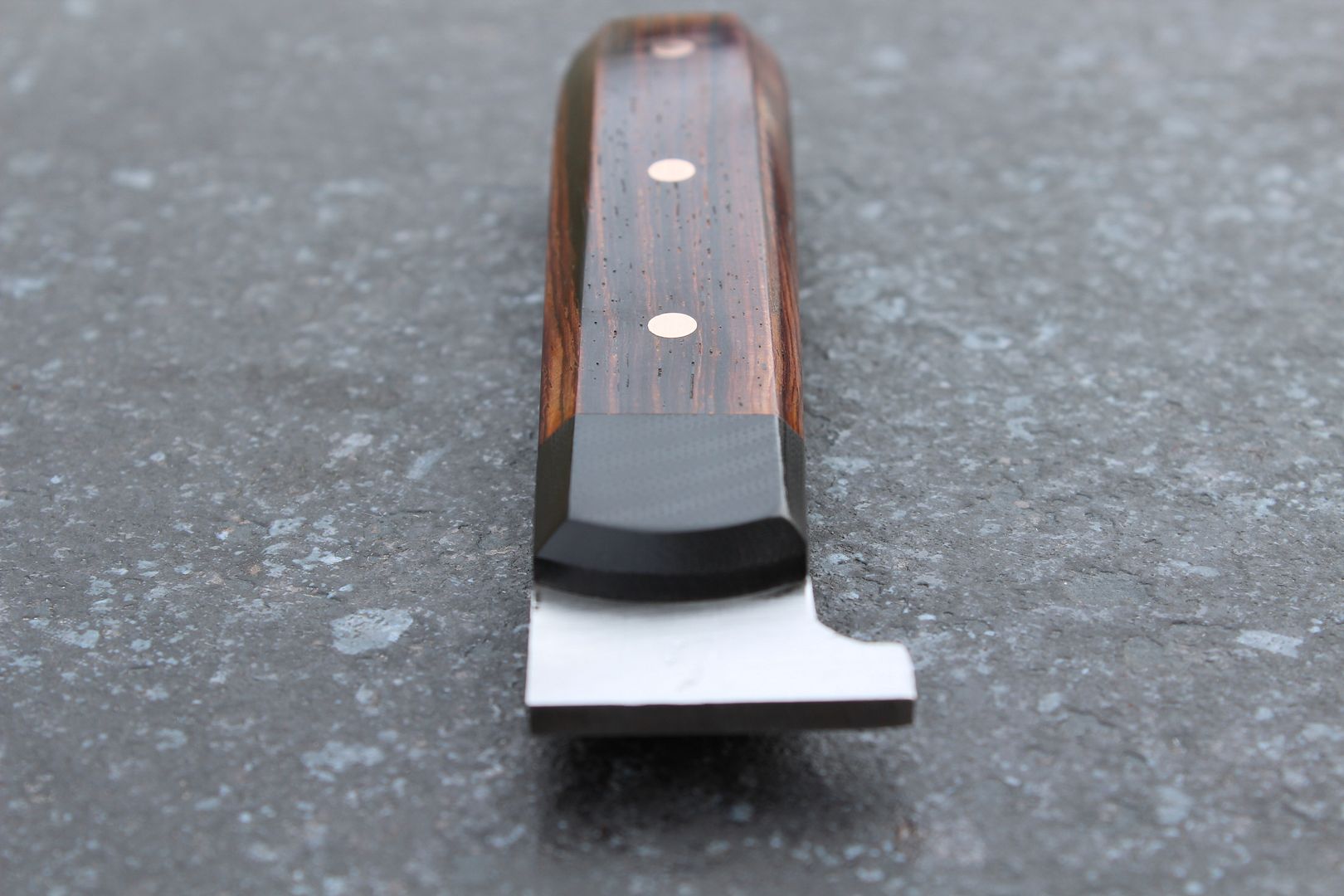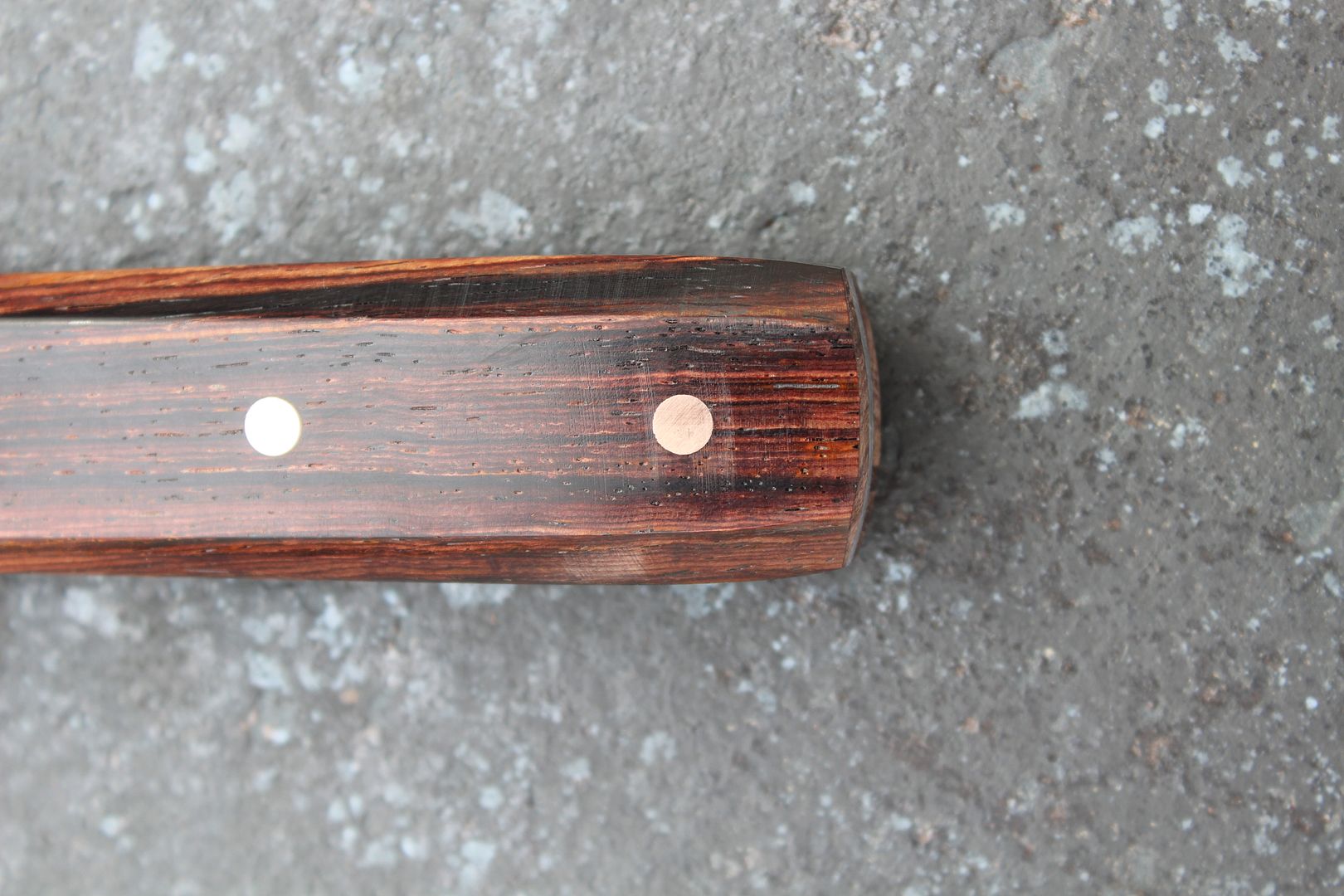Really not into the angled corners on the bolster as well. I'm also not feeling the cleaver handles at all, they look somewhat sterile and unassertive to me. The mosaic pin ruins the third one for me as well, goes against what I feel the knife is going to stand for. I like the mock-up handle best of the options shown, but I always prefer western handles with a slight hook in the butt of the handle for aesthetics and when using varied grips, it really feels like it locks the knife if your hand when doing tip centric work with your index finger on the spine.
You are using an out of date browser. It may not display this or other websites correctly.
You should upgrade or use an alternative browser.
You should upgrade or use an alternative browser.
Possible Lamson Collaboration Line of Knives
- Thread starter franzb69
- Start date

Help Support Kitchen Knife Forums:
This site may earn a commission from merchant affiliate
links, including eBay, Amazon, and others.
- Joined
- Jul 6, 2012
- Messages
- 3,133
- Reaction score
- 20
In Australia we have a saying " a platypus is a duck designed by a committee" I don't think it's possible to reach a "unanimous" design. But the most important thing is not the handle/ bolster its the profile/ grind/ f&f my 2c
Huw, I love that saying. It's hilariously funny and incredibly accurate!
As for a bit of clarification on last night's post, I'm wondering about the proportions of cleaver 1's handle (ferrule/bolster length and thin spacer), with a combo of G10 and cocobolo. As for pins, I'm still all for one, but three is good too. I like the look of the two pins on the cleaver handle, but not everyone will, and it's true "decorate in odds"; it appeals to the eye, naturally...kinda like the rule of thirds, in photography.
Anywho, I'll be out and about, because my best-friend is expecting his first child, today!!!!! I'm sure I'll be on here a bit, while waiting.
As for a bit of clarification on last night's post, I'm wondering about the proportions of cleaver 1's handle (ferrule/bolster length and thin spacer), with a combo of G10 and cocobolo. As for pins, I'm still all for one, but three is good too. I like the look of the two pins on the cleaver handle, but not everyone will, and it's true "decorate in odds"; it appeals to the eye, naturally...kinda like the rule of thirds, in photography.
Anywho, I'll be out and about, because my best-friend is expecting his first child, today!!!!! I'm sure I'll be on here a bit, while waiting.
Notaskinnychef
Senior Member
- Joined
- Nov 13, 2012
- Messages
- 589
- Reaction score
- 1
pregrats to your friend, he has got a few months on my wife and I 
I look forward to another round of handle mock ups.
I look forward to another round of handle mock ups.
with a combo of G10 and cocobolo. As for pins, I'm still all for one, but three is good too.
i'm in agreement with this. it's always nicer to have an odd number, either 1 pin or 3 pins. =D
same with plating on a dish.... odd numbers are better....
and the g10 cocobolo combo
joetbn
Well-Known Member
- Joined
- Dec 6, 2012
- Messages
- 77
- Reaction score
- 1
I'm coming late to this party, but it looks like a great project. In my opinion rosewood with brass pins and bolster would look fantastic and be a great nod to historic American craftsmanship. Nice yellow brass would patina right along with the carbon too. Brass pins is also another nod to the old Sab's
PierreRodrigue
Senior Member
- Joined
- Mar 1, 2011
- Messages
- 1,974
- Reaction score
- 1
Ok, G10 and cocobolo... My wife let me have a few minutes... So its rough!
I tried to incorporate as much as I could from the comments, as well keep simplicity of manufacturing/construction in mind, thus keep cost down.




I tried to incorporate as much as I could from the comments, as well keep simplicity of manufacturing/construction in mind, thus keep cost down.




- Joined
- Feb 28, 2011
- Messages
- 6,006
- Reaction score
- 213
Works for me, Pierre.
skiajl6297
Senior Member
- Joined
- Aug 10, 2012
- Messages
- 490
- Reaction score
- 16
Ding ding ding. We have a winner. Love it.
- Joined
- Nov 9, 2012
- Messages
- 54
- Reaction score
- 0
I'm new to this conversation, but this one looks great to me. Looks like it would be comfortable, look is appealing without going overboard.
RobinW
Senior Member
I think the blade is a tad on the short side...:scratchhead: 
Anyway, this last one looks really nice. I'd buy that.
Anyway, this last one looks really nice. I'd buy that.
Looks great!
- Joined
- Jan 8, 2012
- Messages
- 754
- Reaction score
- 53
Nicely done!
brainsausage
Senior Member
This gets my vote. And I agree with Tom, a spacer would be preferrable.
PierreRodrigue
Senior Member
- Joined
- Mar 1, 2011
- Messages
- 1,974
- Reaction score
- 1
So a simple, thin metal spacer, to match which ever pin we use? Whether copper, brass or stainless?
Do we have a group consensus?
Do we have a group consensus?
brainsausage
Senior Member
So a simple, thin metal spacer, to match which ever pin we use? Whether copper, brass or stainless?
Do we have a group consensus?
Single pin, matching spacer IMO.
PierreRodrigue
Senior Member
- Joined
- Mar 1, 2011
- Messages
- 1,974
- Reaction score
- 1
Unless we use blind pins 3 is better. (2 would be fine as well, but odd numbers have been the dominate voice so far)
Tom ya big lug! Ask a question I can answer instead of a statement! (Sheesh! Live in Ontario and the whole world revolves around you!! Your turn! :razz:
Your turn! :razz:  eepwall: )
eepwall: )
Tom ya big lug! Ask a question I can answer instead of a statement! (Sheesh! Live in Ontario and the whole world revolves around you!!
sachem allison
Senior Member
- Joined
- Aug 5, 2011
- Messages
- 4,306
- Reaction score
- 48
Alright, here we go again. I want to try to get a knife designed, tested and APPROVED by the membership, here. Dave has given us full permission to discuss the project here. I have this, so far, and Lamson is being contacted:
Well, the wheels are in motion...
Also, We likely need about 80 guys (I'm hoping we can bring this down to 50) committed to getting one, in order to make it really happen. Based on comments from a few guys, paired up with ideas I have/also had, my thoughts are going like this:
Lamson, because they deserve to get it right. Brian (at Lamson) cares and from what I've seen, will listen.
Forgecraft profile and maybe even some throwback texturing, if we can. However, slight design changes might happen, as a result of updating the design.
240mm gyuto
Western handle with some flavor.
I'm thinking 2.5-3mm at the heel, with a wicked distal taper, with a combo flat/upper convex (as I call it, almond) grind.
Steel type - either O1, CPM154 (which they're familiar with), or AEB-L. Stainless or carbon has to be decided.
CAD drawing will hopefully be started soon, by a guy who knows a thing or two.
Prototype to be passed around, quickly. Like a "two days and out" kinda thing. I have guys in mind.
As of right now, I say we focus on a gyuto/chef knife, since it's the knife that many of us have 10+ of, and it really is THE kitchen knife. If this actually happens and goes well, we can talk about a suji, petty and parer...though that's probably 320 knives we'd have to commit to, after A LOT of testing and tweaking, on four styles. Pretty daunting, if you ask me.
I coulda sworn the goal was to make a vintage style throwback knife. We are wandering off the path here. Seems like everyone is making their fantasy knife and that is kinda mudding up the waters here. As I understand it the goal is to make an homage knife to the past with modern materials and techniques. We are not making Japanese influenced knives so, wa handles should be out. If you are doing North American vintage knives the vast majority of them have no bolsters or ferrules, Two slabs of wood and 3 to 5 pins. tapered full tang construction on a lot of them and full distal taper on the better ones.
What we can improve upon is the fit and finish, the comfortable shaping of the handle, a good grind, blade geometry and heat treat, Modern steels or vintage steels. This should be a simple, elegant and affordable work horse. less is more here guys. We are over thinking this. we don't even need fancy wood. Remember the wood on these old vintage knives were already high end, rosewood, ebony, cocobolo, walnut and beech. These woods were chosen because they were straight grained, strong woods that required very little maintenance, They were also chosen because with the advent of modern machinery they could be worked easily and with little waste. Any maker here can tell you burl and fancy woods look beautiful but, they are incredibly labor intensive and the waste is ridiculous between, chip outs, bark pockets, stones irregular grain patterns and treatments to stabilize them. All of these things are going to add significant cost to the end product. I don't think the original goal was to make a multi hundred dollar knife. It was to make a high quality, properly ground , heat treated and inexpensive knife accessible to everyone. Lets keep that goal in mind. All of us can get our fantasy knife made by someone we know, this knife is for those people who can't fantasize at that level and shouldn't have too.
Don't want to come off like a dick, just my 2 cents worth.
brainsausage
Senior Member
I coulda sworn the goal was to make a vintage style throwback knife. We are wandering off the path here. Seems like everyone is making their fantasy knife and that is kinda mudding up the waters here. As I understand it the goal is to make an homage knife to the past with modern materials and techniques. We are not making Japanese influenced knives so, wa handles should be out. If you are doing North American vintage knives the vast majority of them have no bolsters or ferrules, Two slabs of wood and 3 to 5 pins. tapered full tang construction on a lot of them and full distal taper on the better ones.
What we can improve upon is the fit and finish, the comfortable shaping of the handle, a good grind, blade geometry and heat treat, Modern steels or vintage steels. This should be a simple, elegant and affordable work horse. less is more here guys. We are over thinking this. we don't even need fancy wood. Remember the wood on these old vintage knives were already high end, rosewood, ebony, cocobolo, walnut and beech. These woods were chosen because they were straight grained, strong woods that required very little maintenance, They were also chosen because with the advent of modern machinery they could be worked easily and with little waste. Any maker here can tell you burl and fancy woods look beautiful but, they are incredibly labor intensive and the waste is ridiculous between, chip outs, bark pockets, stones irregular grain patterns and treatments to stabilize them. All of these things are going to add significant cost to the end product. I don't think the original goal was to make a multi hundred dollar knife. It was to make a high quality, properly ground , heat treated and inexpensive knife accessible to everyone. Lets keep that goal in mind. All of us can get our fantasy knife made by someone we know, this knife is for those people who can't fantasize at that level and shouldn't have too.
Don't want to come off like a dick, just my 2 cents worth.
I believe the primary focus is still there. There has been some fantasy posts here and there, but the general impetus seems to be geared toward a modern throwback, that can be produced on a large scale, without feeling like a mass produced knife. Emphasis there on modern btw.
- Joined
- Jan 8, 2012
- Messages
- 754
- Reaction score
- 53
I coulda sworn the goal was to make a vintage style throwback knife. We are wandering off the path here. Seems like everyone is making their fantasy knife and that is kinda mudding up the waters here. As I understand it the goal is to make an homage knife to the past with modern materials and techniques. We are not making Japanese influenced knives so, wa handles should be out. If you are doing North American vintage knives the vast majority of them have no bolsters or ferrules, Two slabs of wood and 3 to 5 pins. tapered full tang construction on a lot of them and full distal taper on the better ones.
What we can improve upon is the fit and finish, the comfortable shaping of the handle, a good grind, blade geometry and heat treat, Modern steels or vintage steels. This should be a simple, elegant and affordable work horse. less is more here guys. We are over thinking this. we don't even need fancy wood. Remember the wood on these old vintage knives were already high end, rosewood, ebony, cocobolo, walnut and beech. These woods were chosen because they were straight grained, strong woods that required very little maintenance, They were also chosen because with the advent of modern machinery they could be worked easily and with little waste. Any maker here can tell you burl and fancy woods look beautiful but, they are incredibly labor intensive and the waste is ridiculous between, chip outs, bark pockets, stones irregular grain patterns and treatments to stabilize them. All of these things are going to add significant cost to the end product. I don't think the original goal was to make a multi hundred dollar knife. It was to make a high quality, properly ground , heat treated and inexpensive knife accessible to everyone. Lets keep that goal in mind. All of us can get our fantasy knife made by someone we know, this knife is for those people who can't fantasize at that level and shouldn't have too.
Don't want to come off like a dick, just my 2 cents worth.
I think that this was one of the major forks on the project initially. It could have been combined, but the fork as I read was:
1) vintage throwback with modern grind, geometry, proper HT, and quality fit and finish
2) knife that KKF members would recommend without hestitation, better than Shuns, Globals, Germans, and Hattori FH.
This knife is on more on path 2) once we went sabatier profile and passed on single wood scales, which is fine with me. I would also enjoy a 1) per Son's outline. Perhaps if this knife is successful, Lefty and Pierre would organize something along this path.



